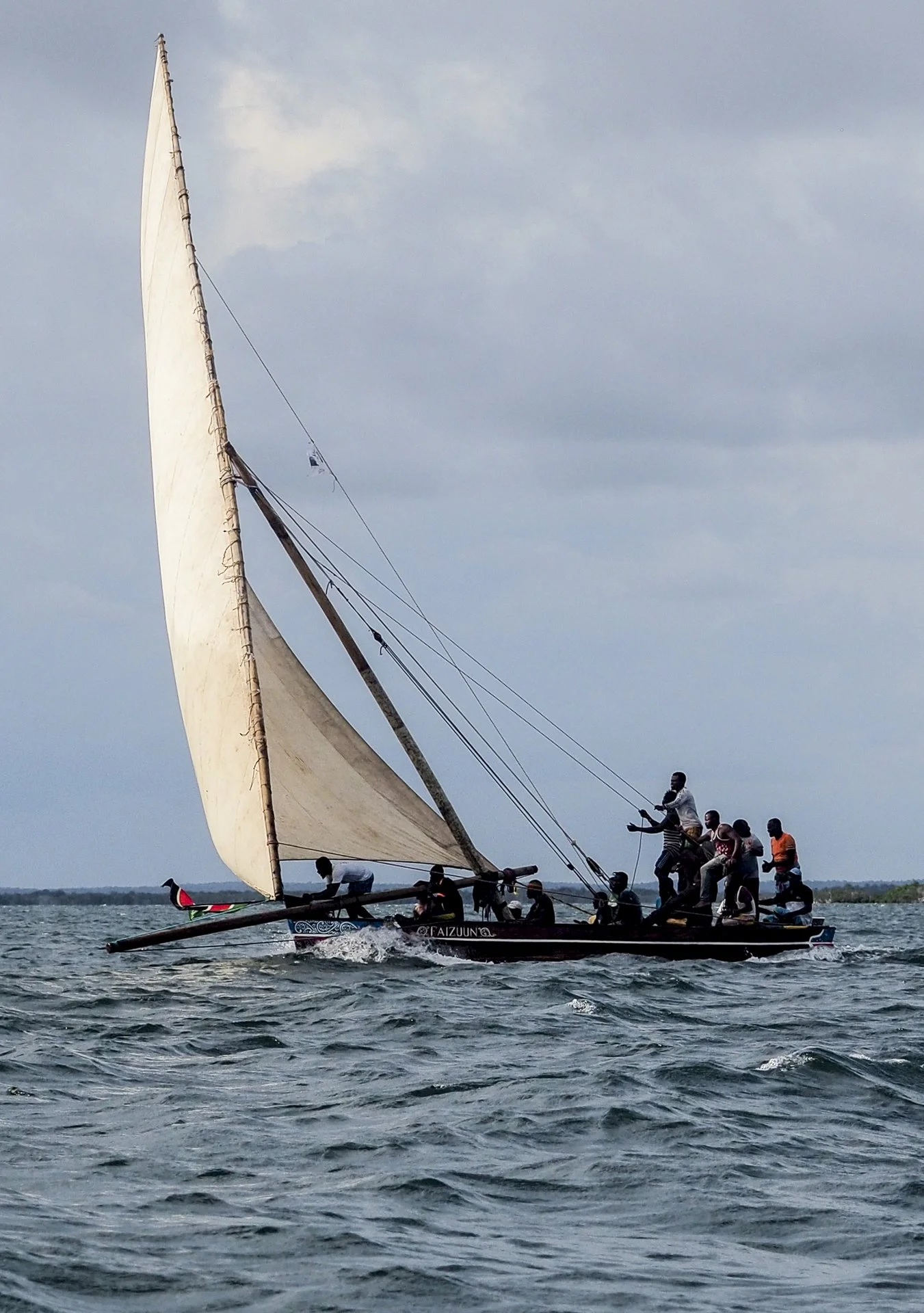How we became fishermen: An exploration of the evidence so far
By Safina Center Junior Fellow Alex Chege
Dhow sailing in the Lamu archipelago, Kenya. Photo Courtesy Alex Chege
The expansion of our species, Homo sapiens, to almost every continent on earth is believed to have occurred during the late Pleistocene (125,000-12,000 years ago). During this time, humans migrated from our ancestral homeland of Africa along the Red Sea coast and into the Levant of southwestern Asia. Humans expanded their range across greater Eurasia, and from there, into the far-reaching corners of Oceania and the New World.
Prior to Homo sapiens arrival on the shores of Australia, 60,000 years ago via water crafts from New Guinea, patterns of human migration in both archaeological and genetic records show predictable movement alongside rivers and coastal routes. It comes as no surprise that what appears to be an avoidance of unproductive deserts, or seasonally glaciated tundra, in favor of a continuous habitat along the water’s fringe has captured the interest of anthropologists studying human evolution.
Humanities tenacity for exploration and expansion into new and varied environments has been made possible by our ability to exploit varied nutritional resources. New habitats tend to vary in availability and diversity of sources of food. And in this way, approaching unpredictable environments through a dietary strategy of high versatility - over the restrictions of specialization - is an advantageous solution when confronted by changing environments.
Anthropologists believe that our dynamic diet coupled with foraging for aquatic and marine foods is causally responsible for our widespread geographic expansion. With the earliest record of marine food use in humans, through remains of stone and obsidian tools, dated at 125,000 years ago on Red Sea coast of Eritrea. It is thought that this foraging behaviour enabled humans to migrate from one end of Africa to the other and eventually into southwestern Asia.
Sunset illuminates the shores of Kiwayu island, Kenya. Photo Courtesy Alex Chege.
Mounting evidence across Africa has shown modern human exploitation of marine food in near-coastal sites in the form of well-preserved remains of shellfish and other aquatic animals. In the western Cape of South Africa, growing collections of these shell middens have become valuable archaeological excavation sites, as numerous types of marine food continue to be found and identified. In some cases, shells have also been thought to be collected for ornamental purposes, indicative of use by modern humans. But why do these sites harbor such large collections? Paleontological signs of human settlement in these locations suggests these served as refugia for Homo sapiens during a time when most of Africa was arid and unable to sustain sedentary human populations.
To add to this, evidence for Neanderthal consumption of marine foods including marine invertebrates (e.g., mollusks) and larger marine mammals such as seals and dolphins have also been recorded in cave sites off the Iberian peninsula. Signatures of human-induced cutmarks, tooth marks on bones and punctured shells demonstrate that these practices were not isolated events but represented continued and intensive exploitation of these marine environments.
Why aquatic foods?
Generally, aquatic food sources can be accessed with relative ease, e.g., when inter-tidal fluctuations cause shellfish to accumulate in bays closer to land. For coastal populations living near marine environments, dispersing along coastal margins would require less energetic expenditure and little technological or behavioral adjustment once capable. These strategies would prove to be stable when moving along larger landscapes. Aquatic foods are nutrient rich in protein and fatty acids (e.g., omega 3), of which these essential dietary components are less commonly accessible to humans foraging in terrestrial environments.
The common octopus (Octopus vulgaris) is often found in shallow inter-tidal waters. This, among other marine invertebrates and fish are nutritional staples for the coastal communities of Eastern Africa. Photo Courtesy Alex Chege.
What remains to be seen is the importance of this nutritional benefit for human fitness. Evolutionary biologists use ‘fitness’ to describe how well an organism is adapted to their environment. And this is reflected in determinant measures of survival, offspring development, and reproductive success.
Despite the seeming importance of this marine foraging behaviour for humanities evolution, archaeologists are reliant on indirect measures of human fitness. However, in the absence of this perhaps observations of aquatic food use by primates - our nonhuman relatives - which occupy similar coastal contexts can provide more answers.
List of key references:
Marean, C.W., 2014. The origins and significance of coastal resource use in Africa and Western Eurasia. Journal of Human Evolution, 77, pp.17-40.
Parkington, J., 2001. Milestones: the impact of the systematic exploitation of marine foods on human evolution. Milestones, pp.1000-1010
Stringer, C., 2000. Coasting out of Africa. Nature, 405(6782), pp.25-27.
Stringer, C.B., Finlayson, J.C., Barton, R.N.E., Fernández-Jalvo, Y., Cáceres, I., Sabin, R.C., Rhodes, E.J., Currant, A.P., Rodríguez-Vidal, J., Giles-Pacheco, F. and Riquelme- Cantal, J.A., 2008. Neanderthal exploitation of marine mammals in Gibraltar. Proceedings of the National Academy of Sciences, 105(38), pp.14319-14324.
Archer, W., Braun, D.R., Harris, J.W., McCoy, J.T. and Richmond, B.G., 2014. Early Pleistocene aquatic resource use in the Turkana Basin. Journal of human evolution, 77,
pp.74-87
Ungar, P.S., Grine, F.E. and Teaford, M.F., 2006. Diet in early Homo: a review of the
evidence and a new model of adaptive versatility. Annu. Rev. Anthropol., 35, pp.209-228.
Walter, R.C., Buffler, R.T., Bruggemann, J.H., Guillaume, M.M., Berhe, S.M., Negassi, B., Libsekal, Y., Cheng, H., Edwards, R.L., Von Cosel, R. and Néraudeau, D., 2000. Early
human occupation of the Red Sea coast of Eritrea during the last interglacial. Nature,
405(6782), pp.65-69.
Will, M., Kandel, A.W. and Conard, N.J., 2019. Midden or molehill: The role of coastal adaptations in human evolution and dispersal. Journal of World Prehistory, 32(1), pp.33- 72.



